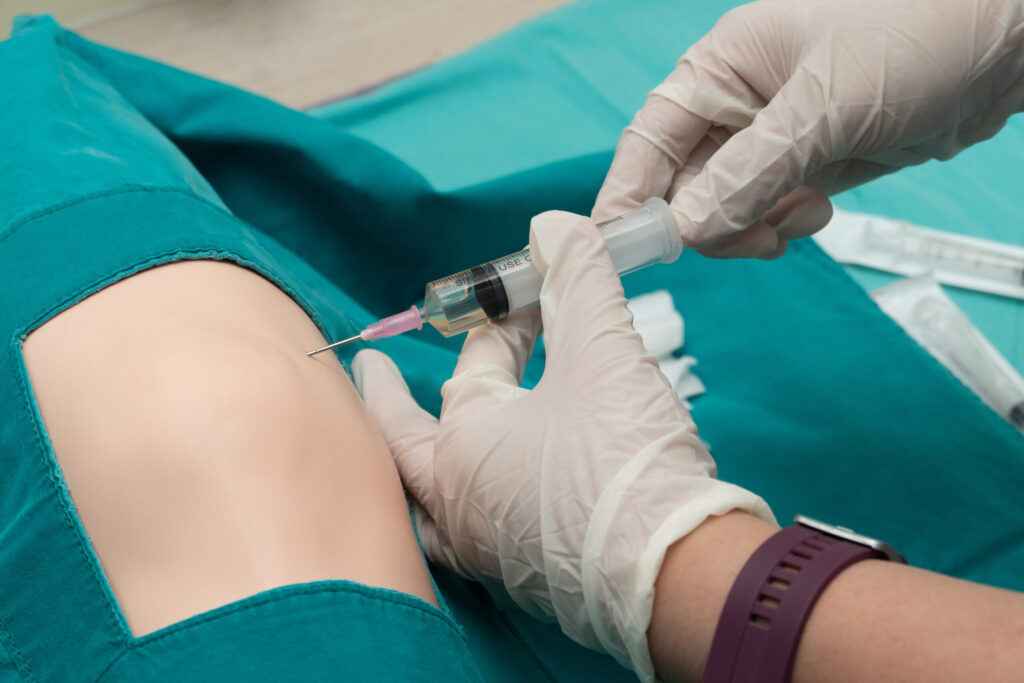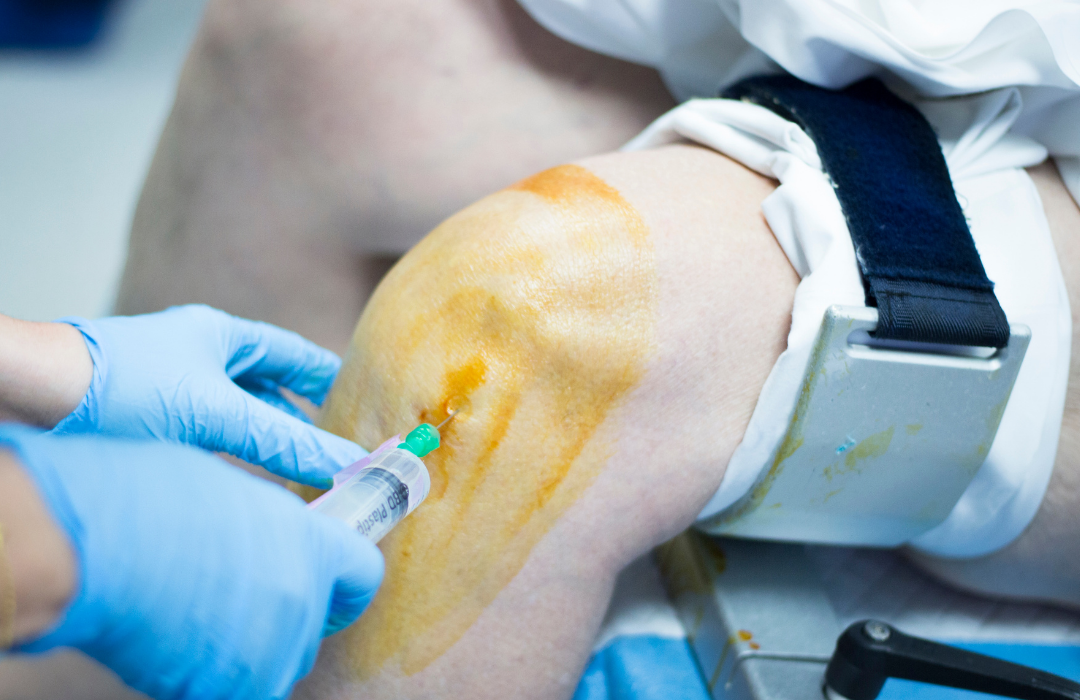Draining the knee has its upsides and downsides. On the positive side, it can quickly ease pain and make it easier to move your knee. It’s also helpful for figuring out what’s causing the trouble in your knee.
On the flip side, the relief might only be for a little while, and there’s a chance the swelling could come back. While the procedure can be a bit uncomfortable, steps are taken to minimize any pain.
Plus, there’s a small risk of infection. In some cases, you might need to do the draining more than once if the real issue with your knee isn’t taken care of.
What is knee aspiration?
In layman’s terms, the procedure entails carefully inserting a needle into the knee to extract a portion of the fluid that has gathered beneath the lining of the joint. This fluid constitutes a blend of blood cells and lubricating chemicals, working with a singular mission—to safeguard the joint and facilitate unhindered mobility as you navigate your everyday activities.
In essence, it’s a protective mechanism ensuring your joints move seamlessly through the demands of your daily tasks.
Why might you need an aspiration? There are two main reasons:

Figuring out the Issue: Sometimes, we use aspiration to collect a sample that helps us understand what might be going on inside your knee.
Easing Swelling: If your knee is swollen and feeling uncomfortable, aspiration can help take away some of that pressure.
How is it used for figuring things out?
Aspiration is utilized to diagnose underlying issues in the knee. The first step involves checking for an infection, which can cause the knee to feel hot, appear red, and be painful. Swiftly addressing infections is essential due to their potential risks.
Once infections are ruled out, the procedure aims to identify other factors contributing to knee pain or mobility issues. These issues may fall into two categories: chronic problems, persisting over time, or acute problems, which are sudden in onset.
Conditions such as arthritis from wear and tear, rheumatoid arthritis, or gout are among the potential causes investigated during this diagnostic process.
How do perform the aspiration?
Aspiration is typically performed in a medical setting such as a doctor’s office, emergency room, or occasionally in the operating room. The targeted area for the procedure is generally a little above and to the side of the kneecap.
Before starting, the area is cleaned with an antiseptic solution. If a local anesthetic is administered for numbing (using a small needle), it precedes the actual procedure. The needle is then inserted through the skin and into the joint for aspiration. The extracted fluid goes into a syringe, potentially multiple syringes if relieving pressure is the goal.
For diagnostic purposes, the process takes around 30 seconds, while for therapeutic relief of swelling, it can last 2-3 minutes. Following the procedure, the injection site is covered with a small bandage.
Pros of Draining the Knee:
Mitigation of Swelling: The primary advantage lies in the substantial reduction of swelling, thereby alleviating pain and enhancing joint flexibility.
Infection Prevention: Through the elimination of fluid pockets, draining the knee serves as a proactive measure against potential infections, curbing the breeding ground for harmful microorganisms.
Enhanced Mobility: By diminishing inflammation, this procedure fosters improved mobility and flexibility, facilitating smoother rehabilitation exercises and daily activities.
Post-Surgery Pain Alleviation: Particularly beneficial post-surgery, the removal of excess fluid brings relief from the additional pain that often accompanies surgical procedures.
Diagnostic Potential: The procedure offers a dual benefit, allowing healthcare professionals to extract fluid samples for analysis. This analysis can unveil underlying issues, guiding subsequent treatment decisions.
Cons of Draining the Knee
Painful Intervention: The invasive nature of the procedure involves needle insertion into the joint capsule, contributing to significant discomfort and potential apprehension for patients.
Infection Risk: The introduction of a needle poses a risk of infection, demanding meticulous adherence to sterile procedures to avert the entry of harmful bacteria.
Potential Allergic Reactions: Individuals with allergies to specific medications used in the draining process may encounter adverse reactions such as rashes, itching, or respiratory difficulties.
Limited Efficacy: Draining the knee has its limitations, proving less effective as a long-term solution for conditions like arthritis or bursitis, necessitating consideration of alternative treatments.
Risk of Scarring: Improper needle insertion may result in scarring, compounding discomfort and potentially undermining the aesthetics of the affected area. Addressing scarring concerns is crucial for overall patient satisfaction.
Does Aspiration hurt?
Yes, The aspiration procedure may cause some discomfort or slight pain when the needle is inserted. There might be pressure on the joint, but the actual removal of fluid usually isn’t painful. If necessary, a local anesthetic can be used to numb the area.
What happens afterward?
After the procedure, you can typically go home. If the spot where the needle was inserted feels a bit sore, you can take simple painkillers. It’s important to keep the area clean and dry until you receive guidance on when to remove the bandage. Once they have the results of any tests done on the fluid, they ‘ll inform you.
Does the pain from swelling completely go away after an aspiration?

If the aspiration was done to address swelling, the pain should improve almost immediately. However, in some cases, alternative methods may be needed, such as injections, regular application of ice, or consultation with a rheumatology expert.
So, It’s also possible for swelling to return in the following weeks or months. The key is to understand the underlying issue in your knee for effective ongoing treatment. In the short term, though, aspiration can significantly alleviate knee discomfort by removing excess fluid.
FAQ’s
Is it bad to get your knee drained?
No, Knee drainage is generally a safe and effective procedure, providing relief from pain and improving mobility. However, like any medical intervention, there are potential risks, such as infection, which are usually minimal.
Does my knee need to be drained?
Yes,Knee drainage may be recommended if you have conditions like arthritis, bursitis, or tendinitis, where removing excess fluid can help relieve pain and enhance joint movement.
What are the dangers of fluid on the knee?
Fluid on the knee can affect muscle function, leading to weakness and atrophy. Additionally, it may contribute to the formation of a Baker cyst, causing pain and discomfort.
What is the recovery time for a knee drain?
After knee drainage, physicians typically advise rest with elevation for about 24 hours. Moderate pain may be experienced but often diminishes within 24 hours, allowing a return to moderate activities the following day.
Is walking good for fluid on the knee?
Yes, Walking and exercise can be beneficial for mild to moderate knee pain due to conditions like osteoarthritis. Physical activity helps mobilize joint fluid and improve joint function.
How can I naturally drain fluid from my knee?
Home remedies for reducing knee swelling include rest, ice, compression, elevation, anti-inflammatory measures, heat application, massage, and specific knee exercises.
What to do after draining knee?
Following knee drainage, it’s recommended to use ice and elevation for the next few days to reduce swelling. Applying these measures every 1 to 2 hours while awake can be helpful.
Can fluid on the knee heal itself?
Yes, In mild cases, fluid on the knee may resolve on its own or with at-home treatments like the R.I.C.E. protocol (Rest, Ice, Compression, Elevation) and gentle compression with an elastic bandage.
Final Words
To wrap up, draining the knee has its good and not-so-good sides. On the positive end, it quickly eases pain, helps you move better, and can figure out what’s causing trouble in your knee.
But, the relief might not last forever, and there could be a bit of discomfort during the process. There’s a small risk of infection too. Plus, you might need to do it more than once if the main issue isn’t fixed. Even with these downsides, when done right, draining the knee can really make a positive difference for folks dealing with knee problems.

